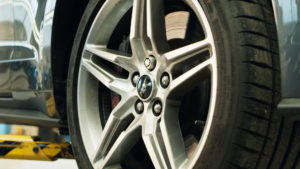
One method to deter wheel thieves is to use locking nuts, one on each wheel, which require a special adapter, or key, to loosen. But even these are not invulnerable.
Engineers at Ford have now developed locking wheel nuts using 3D printing technology.
Together with EOS, a supplier for high-end solutions in additive manufacturing, Ford has created locking nuts with contours based on the driver’s voice.
Like an iris scan or a fingerprint, a person’s voice can be used as a unique biometric identification. Engineers record the driver’s voice for a minimum of one second, saying something like “I drive a Ford Mustang”, and use software to convert that singular soundwave into a physical, printable pattern. This pattern is then turned into a circle and used as the design for the locking nut’s indentation and key.
With the geometry in place, the nut and key are designed as one piece, then 3D-printed using acid and corrosion resistant stainless steel. When finished, the nut and key are separated, with a small amount of grinding required to make them ready for use.
The design also includes second level security features that prevent the nut from being cloned or copied. The unevenly spaced ribs inside the nut and indentations that widen the deeper they go prevent a thief from making a wax imprint of the pattern, as the wax breaks when it is pulled from the nut.
If not using the driver’s voice to create the contours, the nuts could feature designs specific to a vehicle, such as with the Mustang logo, or use the driver’s initials. The design could also take inspiration from a driver’s interest, for example, by using the outline of a famous racetrack.
3D printing, or additive manufacturing, offers design flexibility to help reduce weight, improve performance and create parts that wouldn’t be possible using conventional methods. For more than 30 years, Ford has increasingly used 3D printing to make prototype parts which help reduce the development time for new vehicles.
The company has also used this technology to create parts that feature in the Ford GT, Focus and Mustang GT500, and will make more 3D-printed parts in the future. Special bespoke car parts are also 3D printed, including the intake manifold in Ken Block’s Hoonitruck and the pair of wind louvres found on the M-Sport Ford Fiesta World Rally Championship car.